It’s less than an hour from the end of the 4-wheel-drive track to the fabulous rock-hewn church of Abuma Yemata Geh in Ethiopia, but what an hour! This incredibly perched place, carved into the side of a huge, vertical pillar of rock, would be a wonder in any country (although tourists would never be allowed to make the dodgy climb up there in many), but in Ethiopia, where the jaw-dropping physical location is complemented by a fairly remote and utterly spectacular setting, fascinating people, and a way of life (and worship) that feels as though it belongs to a time in the far distant past, the trip to Abuma Yemata Geh is probably one of the most extraordinary, fascinating, and occasionally terrifying couple of hours I’ve spent in my life!
The rock-hewn church of Abuma Yemata Geh is well-known among travellers to Ethiopia these days – along with the Danakil Depression and the Simian Mountains it’s an unmissable stop on the northern Ethiopian Historic Circuit for those travellers that want to spice up the trip with a little excitement, but it (like the remaining hundred-plus rock-hewn churches carved out of the nearby mountains) remains virtually unknown in the rest of the world.
About 150 rock-carved churches are known to exist in the Tigray region of northeastern Ethiopia, spread around a large area between the cities of Axum (famed for its claim to house the Biblical Arc of the Covenant) and Mekele, and among the ten or twenty churches more commonly visited by travellers, Abuma Yemata Geh probably reigns supreme.
Arriving at the start of the hike up to it, a couple of kilometers south of the dusty, one-street settlement of Megab, it’s already clear why this church so captures the imagination. Ahead rise the great pinnacles of the Gheralta range, spectacular towers of rock rising out the semi-arid plain. We immediately try to guess where on earth the church could be – the towers all look completely unclimbable – and the anticipation is half the fun of getting there, so I won’t mention where on the pinnacle the church is carved, but just say that getting there isn’t as suicidal as it would appear from below.
After passing through the tiny settlement and checking on the whereabouts of the priest, who must be notified before going up there, our little party (me, David, and our guide, which is compulsory in the Gheralta area) is augmented by a pair of scouts and a couple of hangers-on. It’s beginning to look like this will be an expensive little hike, with all the tips we’ll have to give out, but with hindsight I was grateful the scouts came along – I’d never had made it up to the church without their pushing and pulling…!
Soon the trail climbs the slopes below the great cliff face, passes a sacred olive tree, and then reaches the base of the rock face. The climb at first is easy and gentle, with little need for the hands. Then we all have to take our shoes off at the base of a nasty-looking sheer rock face. From below it looks OK: worn but deep-looking footholds zigzag up the vertical cliff, and it looks quite doable. Then I step onto it and realize it’s far scarier than it looks from below…. It’s only ten or 15 meters up, but it’s completely vertical and I was so petrified that it was only thanks to the determined help of the scouts (who showed me where to put my feet and hands, and yanked me up at a critical moment) that I made it up.
After the short but screamingly intense psychological torment of that cliff the remaining ten minutes up to the church are exposed and exciting but far easier and less risky – scrambling up countless rocky faces in Taiwan really helped here! The cliff face itself is not actually really dangerous, but you need a far calmer state of mind than mine to scale it safely, and with no rope, and some very worn holds, you have to be extremely careful – a fall onto the rocks below could easily be fatal. Shortly we reached a small cave in the cliff face on the left – the Baptism Chamber, and a smaller hole, partially bricked up, full of bones of long departed congregation members. A thin and very airy spine of rock crosses the abyss separating the baptism chamber from the main church, and although it looked scary, after what I’d just done, it was more exhilarating than anything.
The location of Abuma Yemata Geh several hundred meters above the ground, halfway up an incredible vertical tower of rock means that the only physically possible approach (unless you belay in of course) is from round the back, and because of this, the church and its mind-blowing situation are only seen a minute or two before you actually reach its entrance, and it makes for an unforgettable first impression. Once up onto the sheer face, a narrow ledge of rock, disconcertingly sloping towards to the brink, edges around the tower for about 20 meters to the safety of the church entrance ‘porch,’ a rounded chamber carved out of the sandstone. Making it safely I found my guide inside glaring angrily at me. It was a few minutes before he could bring himself to tell me what I’d done wrong, but apparently I wasn’t supposed to keep my back to the cliff face and edge along looking fearfully over the vast drop below, but do what everyone else did: face the wall of rock and hold the hand holds carved out of the rock as I edged along…. After surviving the cliff face below, this last bit seemed relatively safe to me, but he insisted I do it the right way going back.
I was so fearful of how I was going to fare on the return down the cliff face that I couldn’t completely enjoy the beautiful interior of the church, but it really was very stunning. As luck would have it, a service was going on when we arrived, and we had to wait until it finished before entering. Finally the priest came out, dressed in long white robes, a turban on his head and a long Ethiopian crook in one hand (reminding me of an actor from a Biblical epic). Behind him, the small congregation of maybe ten seemed to consist of middle-aged women, some in their 50s or early 60s, who calmly proceeded to edge along the narrow ledge, facing the wall, as they started their descent. I could only register awe at how they blithely manage to scale that horrible cliff face every week on their way to church.
I got down with less ‘hands-on’ help from the scouts than I’d received on the way up, although they literally saved me during a couple of heart-stopping moments where I couldn’t find the next foothold and my hand started slipping out of the handhold above… In one of those wonderful, utterly impossible-to-plan but unforgettable bits of luck that occasionally arise while travelling, we hiked down in the company of the priest, his assistant, a striking young man similarly dressed in all his finery, and a few of the congregation, and it was mind-boggling to realize that at this very moment I could have been in Taipei riding the MRT home after a day’s work. The two worlds are just completely irreconcilable.
Abuma Yemata Geh is the ‘star’ among the rock-hewn churches of Tigray, although it’s not the only ‘white-knuckle’ church in Ethiopia. The monastery and church of Debra Damo, not far away to the north, a couple of hours east of Axum, is built in an unlikely position atop a huge, sheer-sided amba (flat-topped hill), and the only way up – famously – is via a twenty meter-long leather rope up a sheer cliff with footholds. Alas, despite the fact that this climb is actually a lot safer than the shorter ‘hard bit’ of the climb up to Abuma Yemata Geh (you have a thick leather rope to hold onto, and a safety rope is tied around your waist and held by someone at the top), despite my best intentions to conquer this one, I bottled out upon reaching the bottom, and only David and a Finnish bloke travelling with us made it up there. It’s a cool-looking spot though, even from the bottom.
We visited another five rock-hewn churches during our two-day drive through Tigray (en route between Axum and Mekele, where we were due to join a tour to the Danakil Depression a few days later), and the remaining churches we saw are all beautiful and extraordinary in their own way. The most interestingly positioned is Petros and Paulos church (one of the three churches in the Teka Tesfai Cluster), also built into a cliff-face. The cliff here is nowhere near as high, sheer, or smooth as the one those fearless people cut Abuma Yemata Guh into, and it’s climbed by an extraordinary contraption made of thousands of tree branches – a sort of cross between a ladder and a flight of rustic stairs; it’s a unique experience.
And then of course there’s Ethiopia’s other cluster of rock-hewn churches – the world-famous ones known as Lalibela. This is one Ethiopian place that needs no introduction. I’d read and seen so many photos of this before our trip that I half expected to be disappointed. I had no need to worry. It would be worth visiting Ethiopia just to see this astounding place (and – crucially – to continuously remind yourself that these churches weren’t ‘built’ but were hollowed out of the solid bedrock – something my poor brain found very hard to accept as I wandered around the magnificent structures).
With these and all the other unique and astonishing sights and experiences Ethiopia has to offer, it’s hard to imagine visiting anywhere else will quite as exciting again.
GETTING TO ABUMA YEMATA GUH and the other Tigray Rock-hewn Churches
While some of the churches in the Tigray region are accessible by bus, we saved time by hiring a car for two days, driving between Axum and Mekele.
Cars and drivers (you can’t self-drive) are easily available in Axum, and drivers (or agents) will approach you in Axum’s streets. Car hire in Ethiopia is extremely expensive: we paid US$250 for two days Axum to Mekele, including visits to Debra Damo and six rock-hewn churches. Expensive but worth it, since we saw a lot more in a short period of time than we would have if we’d tried to go by public transport.
A guide is compulsory for all churches in the Gheralta area (including Abuma Yemata Geh). The scouts aren’t essential, and confident hikers with a good head for heights should have no major problems. Those with a bad head for heights though should seriously reconsider going – the first (and hardest) cliff is a dangerous place to freak out.
Most churches now have a US$6 ‘admission’ fee.
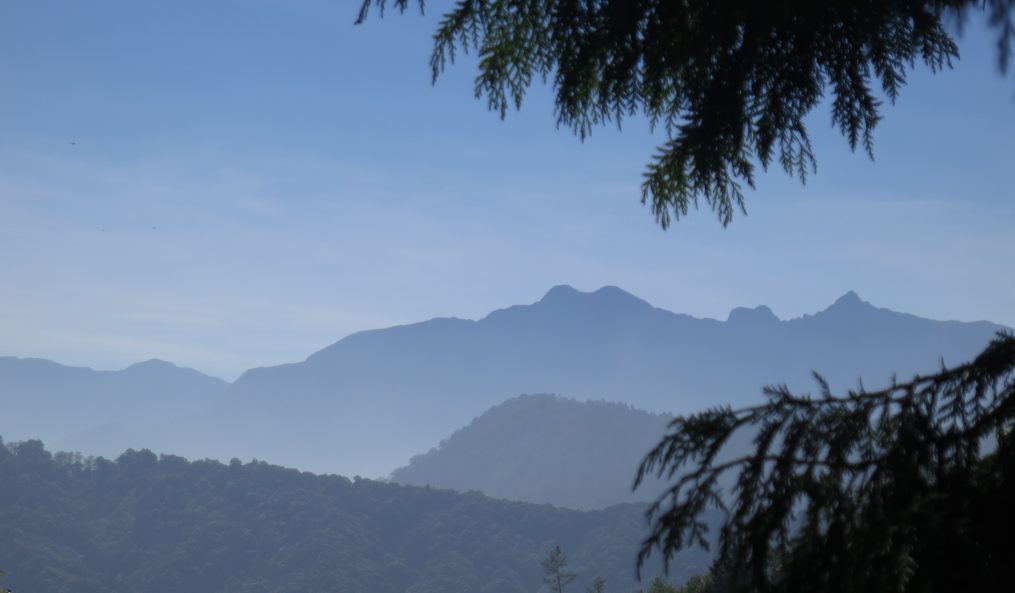





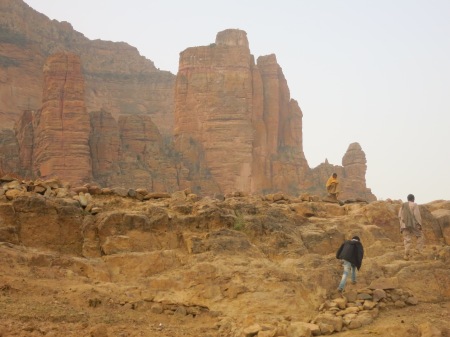






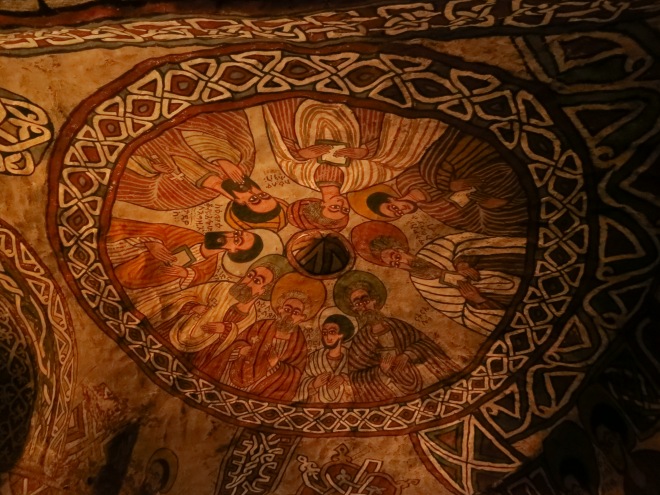
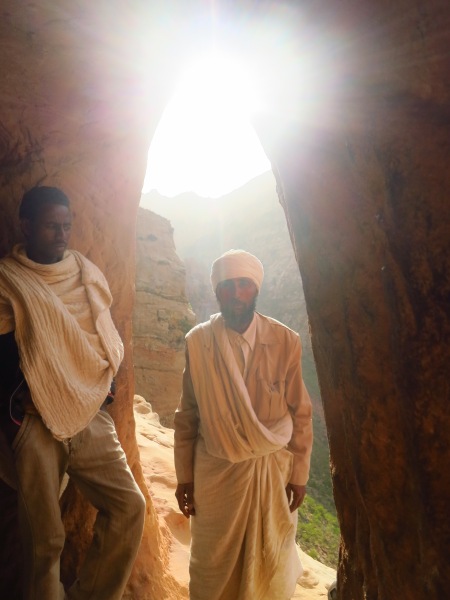



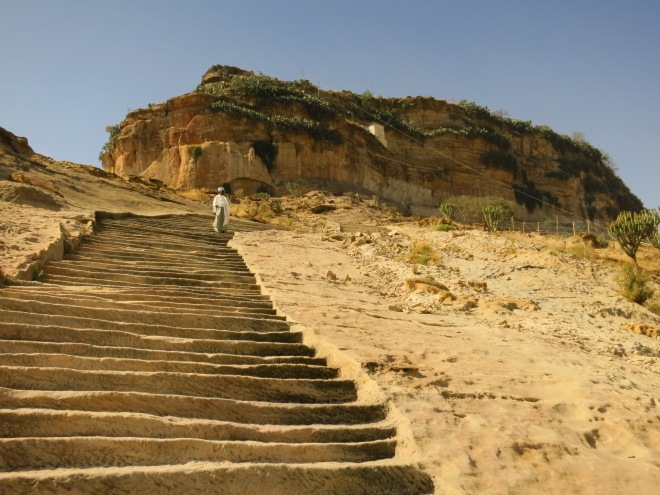













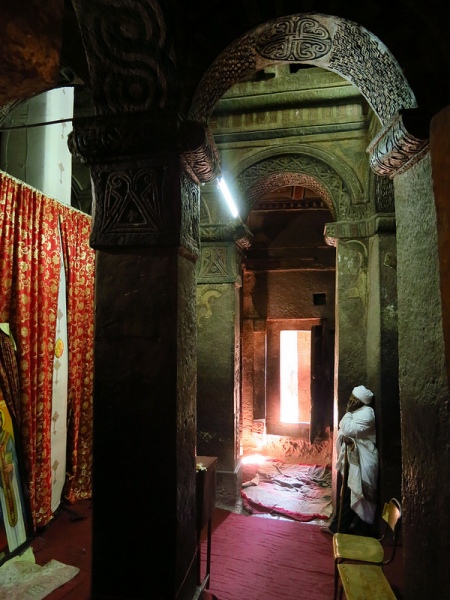


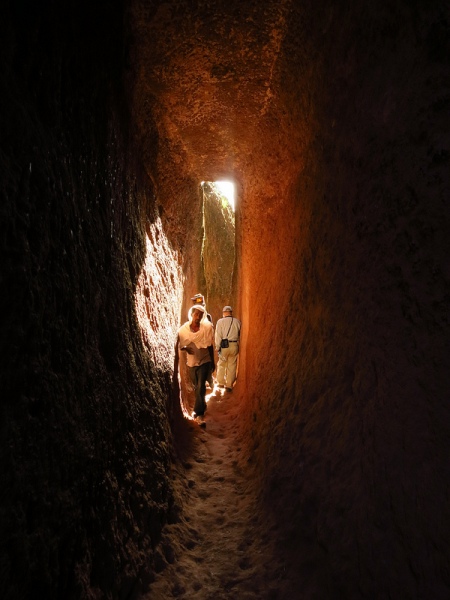

My heart was in my throat reading this! The carved churches have always whispered my name, I’m seeing if I can swing a trip this spring. You mentioned one area where women weren’t allowed, and I think there’s a couple in lalibela. Do you think a solo woman, with a guide, would get to see as much in Tigray?
IT should be no problem – I’ve seen photos of ladies at Abuma and other churches – I’m pretty sure it won’t be a problem. Have fun – it’ll probably be an unforgettable trip!
Pingback: ethiopianstar
Our family is going in July and I’d love to know if you have a list or schedule of the churches you visited? I’m trying to plan our trip myself and I’m not sure if we should stay in Mekele and take day trips out each day from a home base, or drive between Axum and Mekele. One of our daughters suffers from car sickness and long drives are difficult for her.
Your website is the best information I’ve found on the churches. Thank you for sharing with the world!!
Thanks Laura! We explored the churches on a trip with a driver we hired between Axum and Mekele over (I think) two days – we hired the driver in Axum (amazingly reasonable price, although I forgot how much), and saw Debre Damo and Abuna Yehmata Guh of course, plus another three, which the driver chose as being representative. Both Debre and Yehmata are of course pretty strenuous to reach but well worth it! I don’t have a schedule of how we explored the churches (the driver worked it out after we said the main places we wanted to see), but it worked out a pretty relaxing 2-day trip, for Ethiopia at least. One resource well worth taking is the Bradt Guide to Ethiopia, which has info on more churches than the Lonely Planet, so you might want to choose a few that sound interesting from there. Whichever way you see the churches, have a great adventure – Ethiopia (like those amazing rock churches) is unlike anywhere else!